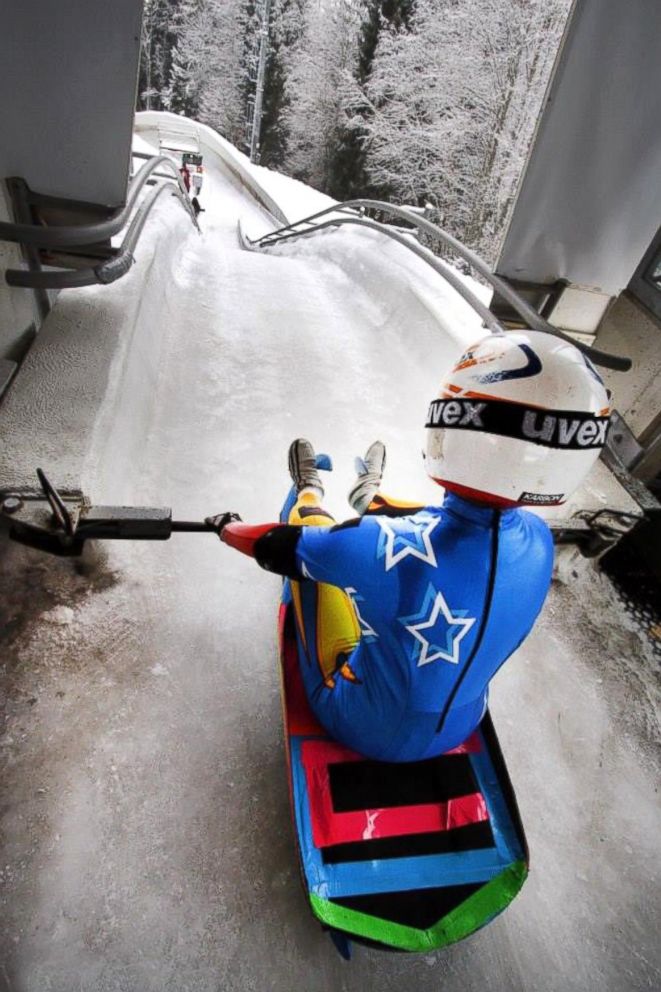Here's What It Takes to Become an Olympic Luger
It's not like there's a pee-wee luge league in every town in America.
Feb. 8, 2014 -- The first time Hannah Miller slid down a luge track at 70 miles an hour she was 12 years old. She remembers feeling nervous looking up at the big ramp on top of a large hill but her mother talked her into trying it, telling her if she didn't like it they could go home.
From the first run, she was hooked.
"The best way to describe it is like a frozen water park ride," she recalled.
Now, at age 16, the upstate New Yorker will be cheering on the American luge team in Sochi with her own dreams of competing in the 2018 Winter Olympics in South Korea.
"I want to represent my country and win a medal. I feel like that would be the coolest thing in my life," she said.
Related: Athletes to Watch in Sochi
While Miller makes it sound as if becoming a luge champion is every little girl's dream, it's not like there's a pee-wee luge league in every town in America.
The majority of youngsters find their way into the sport through a summer slider search clinic held by one of several luge centers sprinkled throughout the country. The Adirondack Luge Club based in upstate New York, for example, holds about half a dozen clinics each year in small towns throughout the Northeast. They set up a ramp in the middle of a street and then invite kids to an introductory workshop.
If a child shows promise, he or she is invited to the Olympic Training Center in Lake Placid, N.Y., during the winter to try out the luge on a real ice track. From there, most kids get into the sport on a recreational level. A few like Miller, who show an aptitude for the sport, go the competitive route.
Kids on the competitive track spend a few years on the development team and then the good ones graduate to the candidate team where they train with the junior national team. Since Miller was first discovered at a slider clinic in Utica, N.Y., she's spent up to 10 months of the year living at the training center -- more than three hours from her home -- or competing abroad in places like Germany and Italy.

Her mother, Amy Miller, said she is immensely proud of her daughter but all that time away from home can be hard.
"She's missed Thanksgiving, Easter, her birthday – we've sacrificed a lot of time with her," Miller's mother said.
Related: Shaun White Ends Bid for 2-Gold Olympics
Jim Murphy, who coached Miller during her first few years of training, said he knew she was an ideal luge athlete from the start. "She's got an aerodynamic build, she has good body awareness on the sled and has a willingness to be coached," he said. "Most of all, she's got a love of the sport."
Murphy said he can tell right away kids like Miller have got it because their eyes light up. He said that excitement is important to carry them through the runs where they slam into a bale of hay and get tossed into the parking lot.
That enthusiasm has also carried the budding Olympian for up to 8 hours a day of training in season, and 6 hours a day during the summer. Miller's typical day starts with a weight lifting or a cardio workout followed by a few hours of sliding on the luge track. She attends school through the Internet, so in between activities, she squeezes in school work the best she can.
"It's been a very long time since I've been out to the movies or out to eat with my friends," she said.
By the time an athlete reaches Miller's level, there are financial hurdles too. Her mother estimates they spend more than $10,000 a year on training, boarding and travel expenses.
"Family vacations go by the wayside but you want your kids to be happy. It's worth it to see her find her passion and purpose in life," Miller's mother said.
Another inevitability in a sport that involves racing down a one-mile track of ice on a sled? Crashes and bang-ups. Miller broke her foot last year and said she's had her share of concussions. But at the moment, she's injury-free.
So far Miller has mainly tasted success. She's medaled in a few national races in the single woman's slider division and spent this season on the international youth World Cup circuit throughout Europe. She believes she's sliding along the right path toward her gold medal aspirations.
But even if she does make the 2018 Olympic team, Miller said she realizes she can't expect more than a few minutes of televised glory. She also knows that lugers don't get fat endorsement deals like the top skaters and skiers do.
She's good with that. The hard work and sacrifice are worth it anyway. She said.
"I'm doing it for my passion of the sport," she said. "I get to travel all over the world doing something that I love – it's the experience of a life time."




